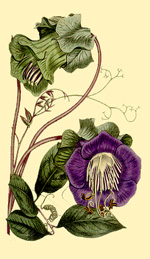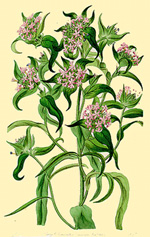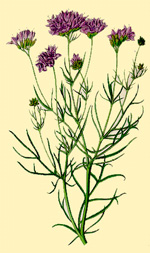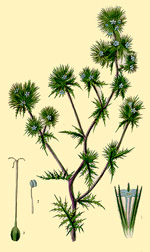 |
This predominantly New World and Northern Hemisphere family is represented in Australia only by a few minor weeds found in the temperate States.
Characteristic features of the family Polemoniaceae in Australia include: - herbs with alternate, entire or paripinnately divided leaves
- flowers in clusters surrounded by floral leaves, tubular, with 5 sepals fused at the base and 5 petals forming a salver-shaped tube
- ovary superior, developing into a capsule
Description
Herbaceous vines climbing by tendrils, or perennial terrestrial herbs. Tendrils terminating the leaves. Perennating by rhizomes. Vegetative reproduction by rhizomes. Internal secretions not obvious. Plants with simple, glandular or non-glandular, uniseriate hairs. Leaves alternate and spiral, cauline, petiolate. Stipules absent; stipellae absent. Lamina simple, once compound or bicompound, paripinnate, symmetric or conspicuously asymmetric, pinnatifid or pinnatisect; lamina/leaflets filiform, acicular, subulate, linear, lanceolate or ovate; base cuneate, attenuate, rounded, cordate or oblique; margins entire, serrate or spiny, ±flat; venation pinnate, with the midrib conspicuous, and the tertiary venation inconspicuous; surfaces not punctate; herbaceous; distinctive odour absent or foetid. All the flowers bisexual. Inflorescences terminal or axillary, consisting of glomerules, cymes or solitary flowers. Bracts present. Bracteoles present or absent. Pollination by insects. Flowers sessile or stalked. Floral disc present; nectaries present on the disc. Perianth of 2 dissimilar whorls. Calyx regular; segments free or fused, with 5 sepals or lobes, valvate or open in bud; calyx bell-shaped or funnel-shaped, herbaceous. Corolla regular or irregular; segments fused, with 5 lobes, alternating with the sepals or calyx lobes, imbricate in bud; corolla bell-shaped, funnel-shaped or salver-shaped, 2-lipped or with palate, orange, pink, violet, blue or green, without contrasting markings, membranous; lobes ±entire. Fertile stamens 5, opposite to the sepals or calyx lobes, at least partly fused to the corolla, free of the ovary and style, distinct from each other, ±equal. Anthers dorsifixed or basifixed, versatile or not versatile, opening inwards by longitudinal slits, 2-celled. Ovary superior and sessile. Carpels 2–3, fused; ovary with 2–3 locules. Style terminal, single and branched above. Ovules 1–numerous, stalked; placentation axile. Fruit a dry, dehiscent septicidal or loculicidal capsule; the perianth on the maturing fruit deciduous, or rotting or liquefying, or dry and persistent. Disseminule macro-surface featureless or with mucilage when wetted; micro-surface ±smooth, brown, dull. Seeds 2–numerous per fruit. Cotyledons 2. Embryo straight or curved.
(Note: this description has been generated from the coded data compiled for the key. Any errors in the key data will be reflected in the descriptions.)
A treatment of the family Polemoniaceae has not yet been published in the Flora of Australia. It will appear in Volume 30.
Australian genera of Polemoniaceae (as recognised for the Flora of Australia)
* = all species introduced
*Cobaea
*Collomia
*Gilia
*Navarretia

|
  |

Cobaea scandens

Collomia linearis

Gilia achilleifolia

Navarettia squarrosa
|
 |
|